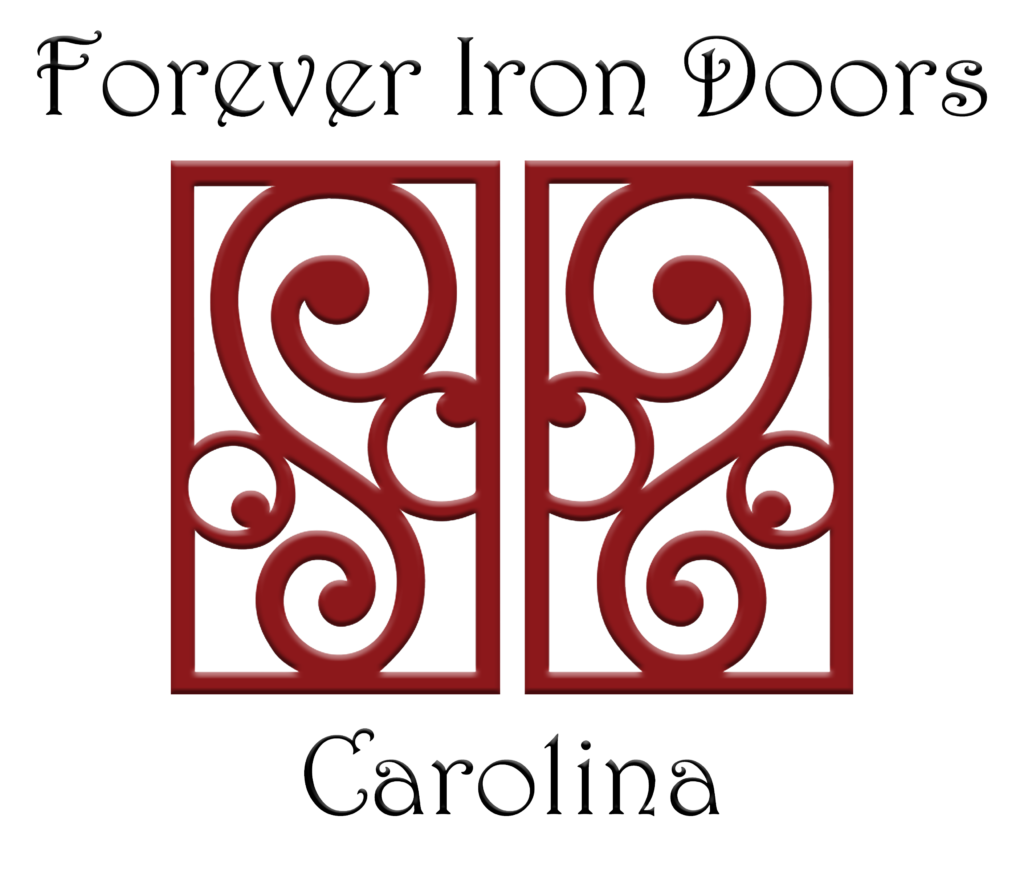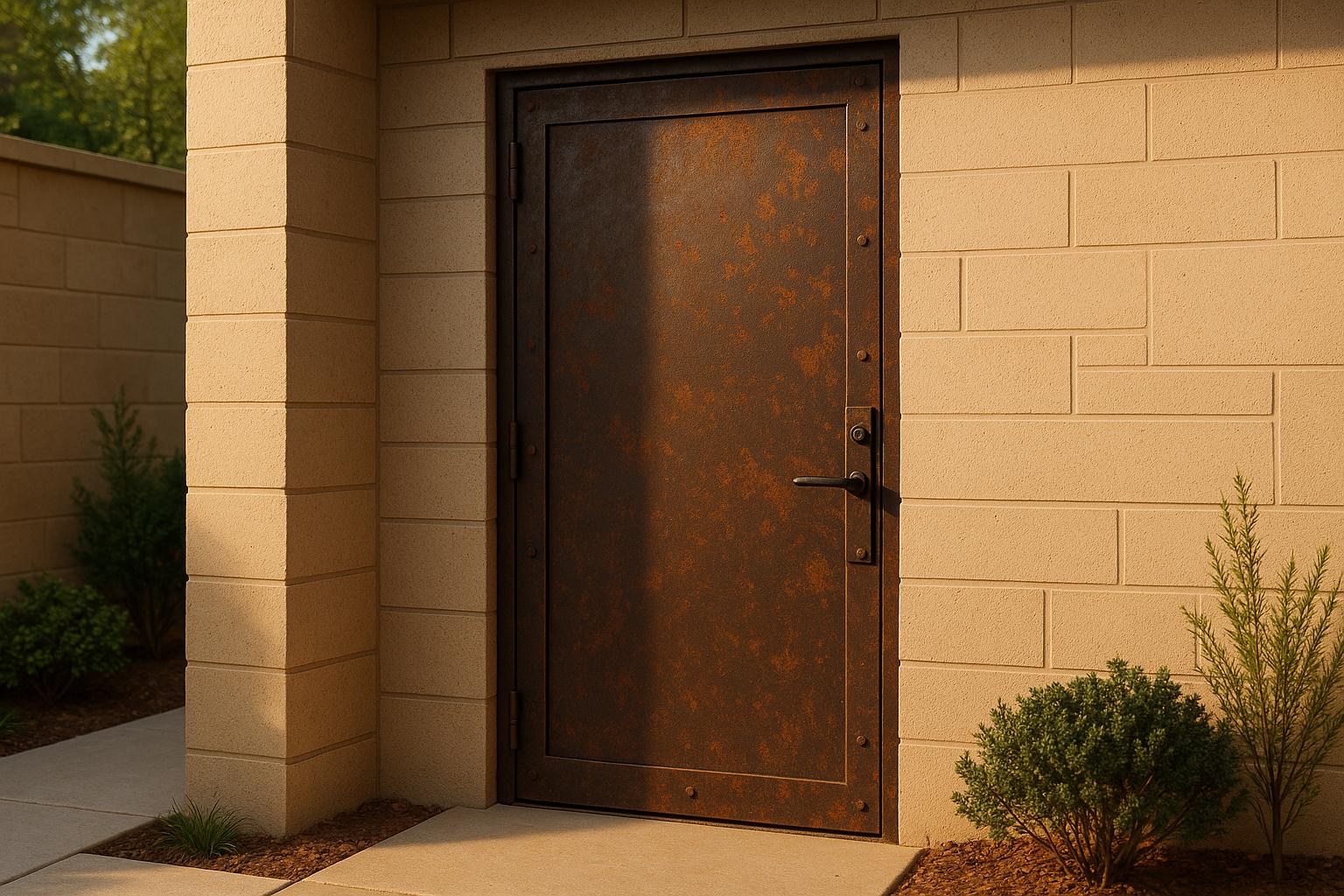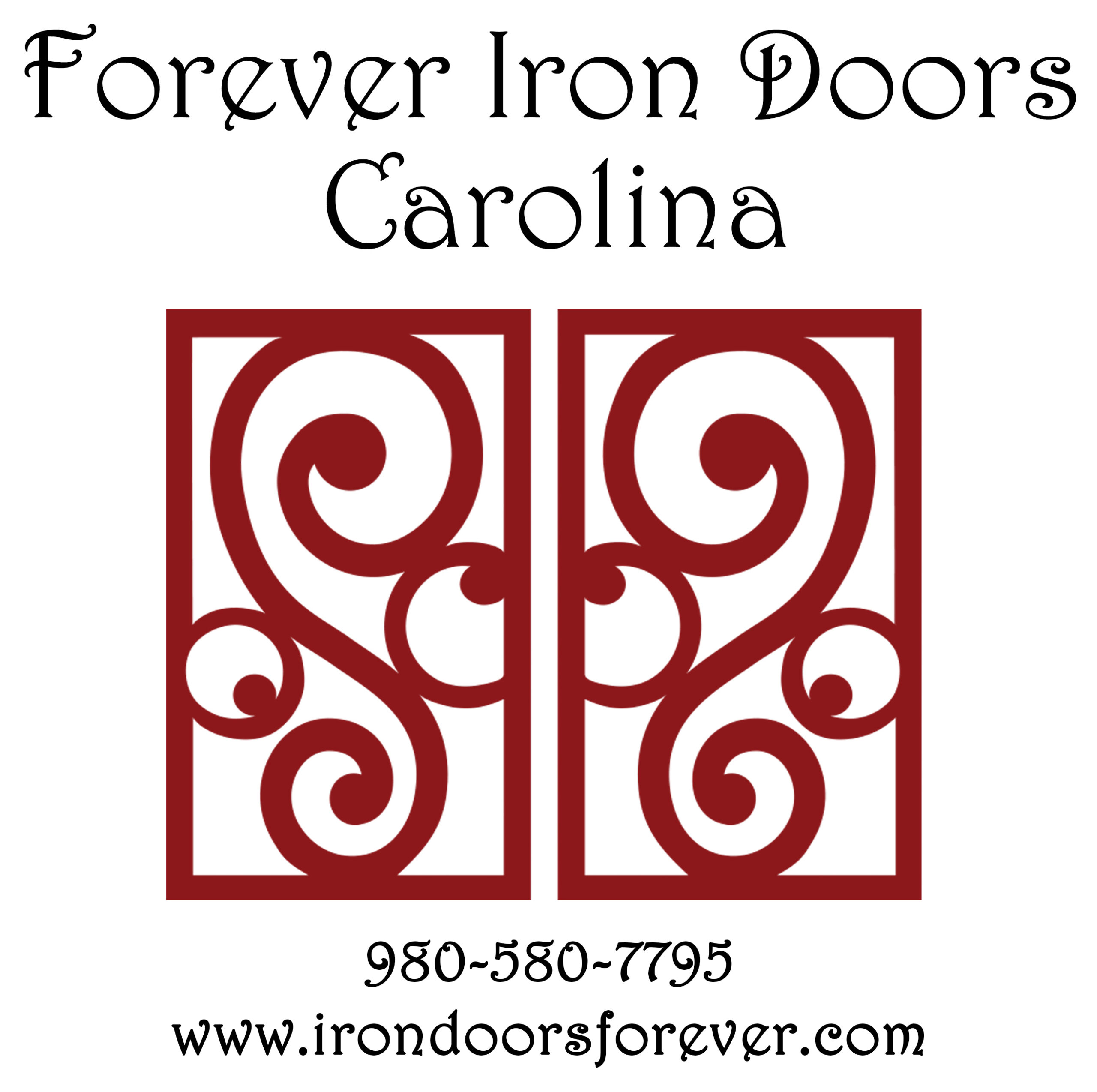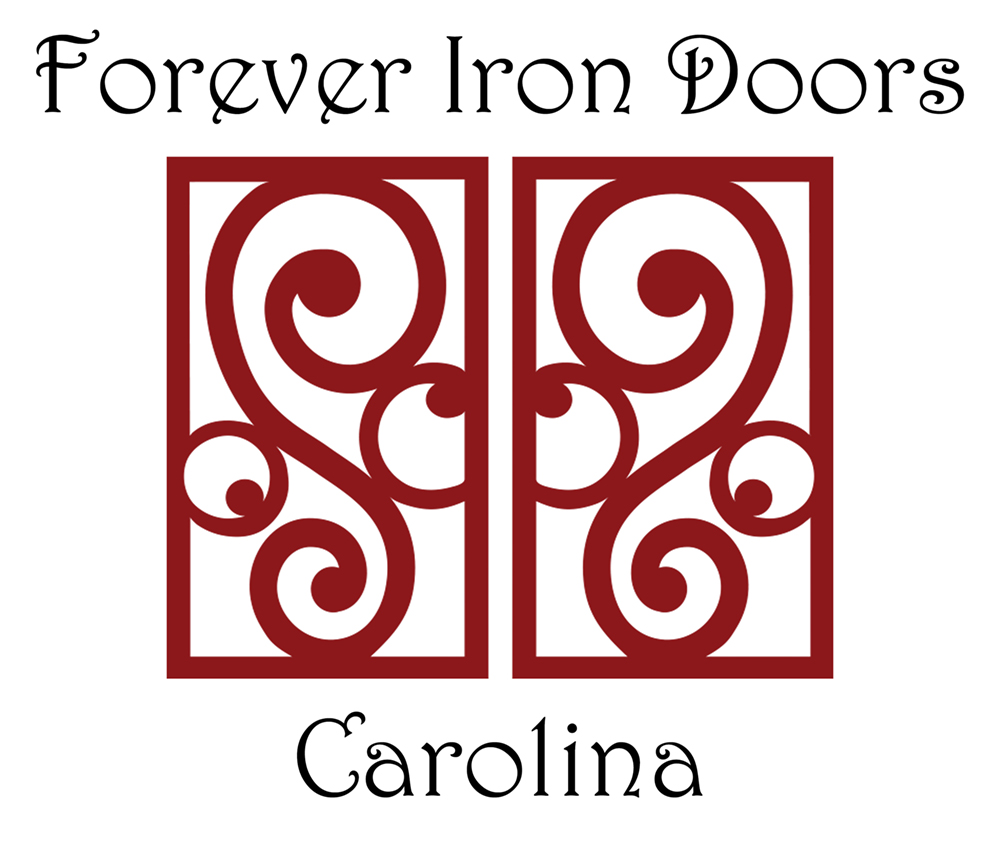Iron doors are durable and stylish but prone to rust, which can weaken their structure and ruin their appearance. Rust forms when iron reacts with oxygen and moisture, often accelerated by environmental factors like humidity, rain, or coastal salt air. With proper care, rust is entirely preventable, and even existing rust can be removed effectively. Here’s what you need to know:
Key Takeaways:
- Why Rust Happens: Oxygen and water cause oxidation, creating rust. Humid climates, salty air, and scratches on the surface speed up this process.
- Prevent Rust:
- Clean monthly with mild soap and dry thoroughly.
- Apply protective coatings like rust-inhibiting paint or powder coating every 6–12 months.
- Lubricate hinges and hardware every 3 months.
- Coastal areas require more frequent maintenance due to salt exposure.
- Remove Rust:
- Use tools like wire brushes or sandpaper for surface rust.
- Apply natural treatments (like vinegar) or chemical rust removers for stubborn spots.
- Follow up with rust-inhibiting primer and protective coatings.
- Maintenance Tips:
- Inspect for rust monthly, focusing on edges, crevices, and hardware.
- Adjust cleaning and sealing frequency based on your local climate.
With regular maintenance and quick action when rust appears, iron doors can last for decades while maintaining their strength and beauty.
Why Iron Doors Rust
To protect iron doors from rust, it’s essential to understand why rust forms in the first place. Rust isn’t just an aesthetic problem – it’s a chemical reaction that can weaken the door’s structure over time.
How Rust Forms
Rust is the result of a process called oxidation. When iron is exposed to both oxygen and water, a chemical reaction occurs, creating iron oxide (commonly known as rust). This compound, with the formula Fe₂O₃·xH₂O, forms when iron reacts with moisture and oxygen in the environment.
"At its chemical level, rust occurs when metal is exposed to moisture and oxygen. The chemical reaction that causes rust is a form of corrosion that slowly eats away at the rusted metal surface…"
During this process, oxygen bonds with the iron, creating oxides that weaken the metal. The visible rust typically consists of Iron(II) oxide (FeO) and Iron(III) oxide (Fe₂O₃). If left untreated, this reaction can completely break down the metal into a brittle, dry oxide powder. The rate of rust formation depends on factors like humidity, oxygen levels, and the type of metal. Over time, this process can significantly impact the door’s durability and structural soundness.
Once rust begins to form, environmental conditions can speed up its progression.
Weather and Climate Factors
Environmental conditions play a significant role in how quickly rust develops on iron doors. High humidity and frequent rainfall provide the moisture necessary for oxidation to occur. For example, areas like North Carolina and South Carolina, known for their naturally humid climates, often see faster rusting on iron doors. Coastal regions face even greater challenges due to the presence of salty air.
"Coastal homes face unique challenges due to high humidity and salty air."
Salt in the air doesn’t just add to the humidity – it also acts as a catalyst, intensifying the corrosion process. This is why iron doors in coastal locations, such as Charleston, SC, or along North Carolina’s coastline, tend to show rust damage earlier than doors located inland. Additionally, rainwater that pools in the door’s crevices or decorative elements provides prolonged moisture exposure, further accelerating rust formation.
Winter weather also contributes to rust. Snow and ice that repeatedly melt and refreeze create wet–dry cycles, which can cause tiny cracks in protective coatings. These cracks allow moisture to seep in, making it easier for rust to take hold.
Beyond weather and climate, the design and condition of the door itself can create vulnerabilities.
Weak Spots in Iron Doors
Certain areas of an iron door are more prone to rust due to exposure or wear. These weak points allow moisture and oxygen to bypass protective coatings, speeding up the oxidation process.
- Scratches and Surface Damage: Even minor scratches can expose bare metal, providing an entry point for rust to form.
- Unsealed Edges: Areas around glass inserts or decorative features often receive less protection, allowing water to seep into gaps.
- Worn Finishes and Hardware: High-traffic spots, such as door handles or areas where the door meets the frame, experience more friction and wear, which can erode protective coatings.
- Decorative Elements: Ornate details often trap water in crevices, making it harder for protective coatings to do their job.
Dirt and grime can also contribute to rust. When debris builds up on the door, it can trap moisture against the surface, wearing down protective layers and giving rust an easier path to form.
How to Prevent Rust
Rust prevention starts with proactive care. With the right steps, you can keep your iron doors looking great and functioning properly for years to come.
Cleaning and Drying Your Doors
Regular cleaning is your first defense against rust. Dirt, dust, and debris can trap moisture against the metal, accelerating oxidation. A consistent cleaning routine is key.
Cleaning Tips
- Clean monthly (or bi-monthly if you live near the coast).
- Use a gentle, vegetable-based soap mixed with water.
- Wipe the surface from top to bottom with a damp, lint-free cloth.
- Rinse with distilled water to avoid residue, and dry thoroughly.
- Apply oil to hinges to ensure smooth operation and avoid rust.
General multi-purpose cleaners or alcohol-based solutions also work well. However, avoid bleach, industrial solvents, or high-alkaline cleaners, as they can damage the protective finish.
"By using gentle, vegetable-based soap, you preserve the overall look of your door while getting the good, thorough clean you’ve been looking for." – Iron Doors Arizona
Why Drying Matters
After cleaning, rinse the door using a hose or a clean, damp cloth, then dry it completely with a clean towel. This step is critical because leftover moisture can trigger oxidation. Don’t forget to lubricate the hinges for added rust protection.
For a detailed walkthrough, check out our comprehensive guide on cleaning iron doors.
Once your door is cleaned and dried, adding a protective coating will help shield it from the elements.
Protective Coatings
Protective coatings create a barrier against moisture and oxygen, preventing rust from forming.
Coating Options
- Use metal-specific paints with rust inhibitors.
- For outdoor doors, opt for exterior-grade paints with UV protection to prevent sun damage.
- Powder coating is a durable choice, offering a thicker and harder finish than regular paint.
- Other options include weather-resistant enamel, clear polyurethane sealants, or wax-based protectants for added moisture resistance.
Reapplication Matters
To maintain protection, reapply sealants every 6–12 months, depending on your climate and how much exposure your door gets.
DIY vs. Professional Application
While some coatings can be applied at home, professional powder coating ensures even coverage and proper surface preparation for longer-lasting results.
Extra Steps
- Lubricate hinges every three months.
- Use rust-resistant hardware when replacing components.
These small actions can prevent rust in vulnerable areas and extend the life of your door.
Extra Care for Coastal Areas
If you live near the coast, your doors face unique challenges. Salt air, high humidity, and strong winds significantly increase the risk of rust.
Step Up Maintenance
In coastal areas, clean and maintain your doors quarterly instead of every six months. Apply a wax-based sealant every three months to combat salt exposure.
Combat Salt Buildup
Salt is highly corrosive and accelerates rust. Rinse your door and hardware with fresh water regularly to remove salt deposits. This simple step helps preserve the protective coating.
Respond to Weather Quickly
After rain or high humidity, wipe down your doors with a dry cloth to prevent moisture from setting in. Coastal weather can be unpredictable, so quick action is essential.
Hardware Maintenance
- Clean hinges and locks with anti-rust spray regularly.
- Inspect weatherstripping and bottom seals to ensure they’re intact.
- Plan to reseal or repaint annually for added protection.
"If you live by the sea, invest in quality now or pay in repairs later. Material is 50%, but finish and hardware are the other 50%." – CATHERIN, International Operations Manager, Zonle Doors
With consistent cleaning, protective coatings, and extra care tailored to your environment, you can significantly extend the life of your iron doors.
How to Remove Existing Rust
Rust doesn’t just look bad – it can cause serious damage if left untreated. The longer you wait, the deeper it penetrates, making removal more difficult and potentially compromising the metal.
"When rust appears, it’s advisable for you to remove it as soon as you can to prevent it from spreading." – Mr. Rogers Doors
The good news? With the right tools and techniques, you can remove most rust and protect the surface to prevent future damage. The process involves cleaning, removing rust (mechanically or chemically), and applying protective coatings.
Step-by-Step Rust Removal
Before starting, assess the severity of the rust. Surface rust is easier to tackle than deep, pitted corrosion that has eaten into the metal.
1. Initial Cleaning
Wash the affected area with mild soap and water using a soft cloth or brush. Rinse thoroughly and dry completely to avoid new rust forming during treatment.
2. Mechanical Rust Removal
Use tools like a wire brush, steel wool, or sandpaper to scrape away loose rust. Be gentle to avoid damaging the metal underneath.
3. Natural Rust Treatment
For a chemical-free approach, try white vinegar or a baking soda paste. Apply the solution, let it sit for about 30 minutes, and then wipe it clean with a soft cloth.
4. Final Cleaning and Preparation
Once the rust is removed, clean the area again to eliminate any remaining residue. Make sure the surface is completely dry before moving on.
5. Protection Application
Apply a rust-inhibiting primer designed for metal surfaces. After the primer cures, add at least two coats of paint suitable for exterior metal, allowing proper drying time between layers. To finish, use a protective coating like a clear sealant, wax, or oil to shield the metal from moisture and air. These steps will help keep rust at bay and maintain the treated area’s durability.
If stubborn rust remains after these steps, consider using chemical rust removers.
Rust Removal Products
When manual and natural methods fall short, chemical rust removers can handle the job.
"Rust removers use a simple chemical reaction to break down rust, separating it from the surface of metal so you can wipe it away."
Types of Rust Removers
- Acid-Based Removers: These work quickly on bare iron and steel but require careful handling due to their caustic nature.
- Sodium Hydrosulfite: A gentler option for delicate details.
- Chelating Removers: Non-toxic, acid-free, and biodegradable, these are safer for indoor use and around plants, though they work more slowly.
- Petroleum-Based Solvents: These not only remove rust but also leave a protective film on the surface.
- Rust Converters: These transform rust into a paintable surface, ideal if you plan to repaint.
Product Examples and Pricing
Several products stand out for rust removal:
- Evapo-Rust ERO12: Priced around $30 on Amazon, it’s highly effective. NASA testing showed that after six hours of soaking, metal surfaces were mostly clean, and after 12 hours, they were spotless.
- Corroseal Water-Based Rust Converter: Costs $62–$65 and works well for converting rust.
- WD-40 Specialist Rust Remover Soak: Available for about $33.
- Jelmar CLR Pro: A budget-friendly option at $12.
Application Forms
Rust removers are available in liquids, sprays, gels, and powders:
- Liquids: Best for soaking small items like screws or bolts.
- Sprays: Ideal for hard-to-reach spots like hinges or intricate designs.
- Gels: Perfect for vertical surfaces, as they stay in place for targeted cleaning.
Safety Tips
Always wear gloves and eye protection when working with chemical rust removers. Ensure proper ventilation if working indoors, and follow the product instructions carefully, as application methods and contact times may vary.
Once rust is removed, applying protective measures is key to maintaining the surface and preventing future corrosion. Proper care ensures the door stays in great condition for years to come.
sbb-itb-cd90297
Choosing Rust-Resistant Finishes
Selecting the right finish for your iron door is essential to protect it from rust. A proper finish not only prevents corrosion but also enhances the door’s overall appearance.
Best Finishes for Rust Prevention
Different finishes provide varying levels of protection against rust:
- Powder Coating: This finish is thicker and far more durable than traditional paint, offering excellent resistance to chips, scratches, and weather damage. The process involves applying a dry powder, which is then heated to form a uniform, protective layer around the metal.
- Faux Painting: Ideal for decorative purposes, faux painting can mimic finishes like aged bronze, rust patina, or antique copper. While it adds aesthetic value, it’s less durable and may require more frequent upkeep, especially in harsh weather conditions.
- Sandblasted Finishes: Sandblasting creates a smooth, defect-free surface that prevents moisture from getting trapped. This process not only increases the metal’s durability but also prepares it for additional protective coatings.
Beyond finishes, smart design choices can also play a big role in preventing rust.
Custom Design for Better Protection
Thoughtful design features, such as well-placed glass, hardware, and framing, can significantly reduce moisture retention and improve resistance to corrosion.
For example, integrating drainage systems into the door’s design helps prevent water from pooling in vulnerable areas. Sloping sill drainage channels direct water away from the frame, while galvanized steel reinforcements offer added protection in high-moisture environments. Strategically positioning hinges, handles, and locks away from direct exposure to the elements – and using weatherproof seals – provides extra barriers against moisture infiltration.
Sealed glass units with built-in drainage channels can also help prevent condensation buildup, which often accelerates rust formation. If you’re planning a custom iron door, understanding the design process can help you work with professionals to incorporate these protective features from the start.
However, even the best finishes and designs need proper installation to ensure long-term protection.
Why Professional Installation Matters
No finish or design is effective without proper installation. Professional installers ensure a precise fit, eliminating gaps where moisture could seep behind protective coatings. They also calibrate door hardware to create the right closure pressure against weatherstripping, which is vital for sealing out moisture.
Additionally, skilled installers address structural elements, such as framing and drainage systems, to prevent settling or warping that could compromise the door’s protection. In areas with high humidity or near the coast, professionals familiar with local conditions can adapt installation techniques to meet specific environmental challenges.
Ongoing Care and Inspection
Once you’ve tackled rust prevention and removal, keeping up with regular care is the key to ensuring your iron door stays in great shape. Even the most durable finishes and expert installations need routine attention to keep rust at bay. A consistent maintenance schedule can help you catch potential problems early, saving you from expensive repairs down the line.
Monthly Inspection Checklist
Make it a habit to inspect your iron door for the first signs of rust. Spotting issues early can stop small problems from turning into major headaches. Keep an eye out for reddish-brown spots, bubbling paint, or rough patches on the surface. Pay close attention to areas like hinges, corners, and decorative scrollwork – these spots are prone to water buildup. The bottom panel and threshold are also trouble zones, especially near the weatherstripping, where rust or discoloration can sneak in. Don’t forget to check handles, locks, and other decorative elements. If you find rust, act quickly to remove it. Regular cleaning is also a must – dust and debris can trap moisture, which is a recipe for rust. Wipe down the entire door with a clean, dry cloth to keep it free of buildup.
Seasonal Maintenance Tasks
For homeowners in North and South Carolina, seasonal care is especially important to keep iron doors rust-free and looking their best.
- Spring and Summer: With higher pollen levels and frequent rain, you’ll need to clean your door more often. Early summer is a good time to reapply sealant to protect against moisture. Pollen can hold onto water, so don’t let it linger.
- Fall: Clear away leaves and other debris from the base of your door. Inspect the bottom panel and weatherstripping to make sure water isn’t pooling there.
- Winter: After snow or ice exposure, wipe down the door to remove moisture. Avoid using de-icing salts near the door, as they can speed up rust formation.
By following these seasonal steps, along with regular cleaning, you’ll strengthen your door’s resistance to rust.
Safe Cleaning Products to Use
Using the right cleaning products is essential for maintaining your door’s finish while getting rid of dirt. Stick to warm water and mild soap for general cleaning, and always dry the surface thoroughly to avoid water spots. For tougher grime or pollen buildup, try a mix of one part white vinegar to three parts water. Stay away from harsh cleaners like bleach or ammonia, as well as abrasive scrubbers, which can damage the protective coating. For a more detailed guide on cleaning and product suggestions tailored to your door’s finish, check out our how to clean iron doors guide.
Conclusion
Keeping your iron door rust-free is straightforward with a little consistent care. Regular cleaning helps prevent moisture buildup, while applying protective sealants every 6 to 12 months adds an extra layer of defense against the elements. These simple steps go a long way in maintaining your door’s condition and appearance.
If rust does show up, quick action is key. For minor spots, fine-grit sandpaper and touch-up paint can do the trick. For more serious corrosion, use a trusted rust remover. Addressing rust promptly ensures your door stays strong and looks great, preserving both its structure and visual appeal.
Professional customization and proper installation also play a big role in minimizing rust, reducing maintenance needs, and extending the door’s lifespan.
With regular upkeep, an iron door can last over 30 years, boosting both security and property value. Whether you live in a coastal area like Charleston or an inland city such as Charlotte or Raleigh, adjusting your maintenance routine to fit local conditions – like cleaning more often in salty air – will help your door stay in top shape for decades.
Custom wrought iron doors can be designed with rust-resistant features when installed by experts. By blending thoughtful maintenance with professional design and installation, your iron door can remain durable, functional, and a stunning focal point for years to come.
FAQs
What are the best coatings to protect iron doors from rust, and how often should they be reapplied?
To keep iron doors rust-free, consider using powder coatings, galvanized finishes, or high-quality rust-inhibiting paints like Rustoleum Hammered Finish. These coatings act as a strong shield, protecting the metal from moisture and corrosion.
For the best results, reapply the coating every 3 to 5 years, or earlier if you notice any wear or damage. Factors like humidity, frequent rain, or being near saltwater can affect how often maintenance is needed. Staying on top of this upkeep will help your iron doors remain in excellent condition for years.
What’s the best way to remove rust from iron doors without damaging them?
To get rid of rust on iron doors safely, start by mixing equal parts of white vinegar and water. Use a soft cloth or sponge to gently scrub the rusted spots – this helps avoid scratching the surface. If the rust is stubborn, switch to a commercial rust remover made for delicate metals and carefully follow the instructions on the product. Once the rust is gone, rinse the area with clean water and dry it completely to prevent any new corrosion.
To stop rust from coming back, apply a rust-inhibiting primer or a protective paint. Regular upkeep, like cleaning the doors and checking for signs of wear, can go a long way in keeping them in great shape and extending their life.
How can I protect my iron doors from rust in coastal areas with high humidity and salty air?
To keep your iron doors in great shape in coastal areas, start with regular cleaning using fresh water and mild soap. This helps wash away salt and moisture that can lead to corrosion. Once clean, apply a sealant or rust-resistant paint specifically made for coastal environments. Make it a habit to inspect the door every year and reapply the coating as necessary to ensure its longevity.
Another tip is to opt for weatherproof, corrosion-resistant hardware for parts like hinges, handles, and locks. Following these steps can help prevent rust and keep your iron doors both functional and visually appealing for years.



